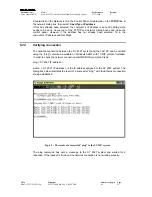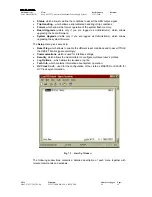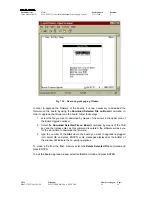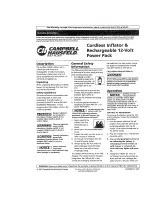
Document type:
Title:
Revision date:
Revision:
User's Manual (MUT)
Mod. SY2527, Universal Multichannel Power Supply System
27/11/2000
0
NPO:
Filename:
Number of pages:
Page:
00103/97:2527y.MUTx/00
SY2527USERMANUAL_REV0.DOC
84
51
•
I1SET
(settable):
the second of the two allowed current limit programmable
values.
•
RDWn
(settable):
the Ramp-Down parameter value, i.e. the maximum voltage
programmable decrease rate.
•
BdStatus
(monitor): it displays the status of the board. Refer to § 7.1.9.2, p.53 for a
list of the possible board status which can be displayed here.
•
HVMAX
(monitor):
the hardware voltage limit for the board channels. It is adjusted
via the relevant trimmer placed on the board front panel.
•
TEMP
(monitor):
the temperature value detected on the board by the relevant
sensor. If this value is out of the range TMIN
÷
TMAX, where
TMIN and TMAX are the two threshold temperature parameters
depending on the type of board, the system signals an Over
Temperature condition (see § 4.3.9). Refer to the
User’s
Manual
of the relevant board for further details.
•
RUp
(settable):
the Ramp-Up parameter value, i.e. the maximum voltage
programmable increase rate.
•
POn
(settable EN/DIS):
Power-On option, which can be enabled or disabled.
If this option is enabled, at Power-On or after a Restart each
channel is restored in the same condition (defined by the
Power parameter) it was before the Power-Off or Reset. If this
option is disabled, at Power-On or after a Restart all the
channels are off, independently from the condition in which
they were before the Power-Off or Reset.
•
PDwn
(settable KILL/RAMP):
Power-Down option, which can be set as KILL or
RAMP. It affects the way the channels react at a Power-Off
command caused by a TRIP condition. If the KILL option is
selected, the relevant channel will be switched off at the
maximum rate available. If the RAMP option is selected, the
voltage will drop to zero at a rate determined by the value of
the Ramp-Down parameter programmed for that channel.
•
CH #
(monitor):
Channel address. It consists of three numbers (refer to Fig.
4.2): the first indicates the cluster to which the crate belongs,
the second number indicates the slot where the relevant
channel board is plugged into, and the third number identifies
the number of the channel. Refer to § 2.1, p.10 for the
definition of cluster.
This field becomes red if the channel is not in a steady status
(normal operation). If the system is operated from an external
terminal it blinks instead of being red.
Both the compact switch or the arrow keys of a standard keyboard can be used to move
through the columns containing the parameters.
To return to the
Menu Bar
, press the TAB key (COMMAND key on the keypad).
The channel parameters visualisation described above refer to the
Group 00
, which, by
default, is the channel group containing all the channels available. It is also possible to
display just a subset of the channels available by defining a different channel group. This
operation is performed through the
Groups
menu in the
Menu Bar
displayed as the
Channels Window
is entered. This menu is fully explained in § 7.1.13, p.55. Moreover,
it is possible to customise the number, type and position of the parameters to be
displayed. This is done via the
View
menu, as described in § 7.1.14, p.58.
















































